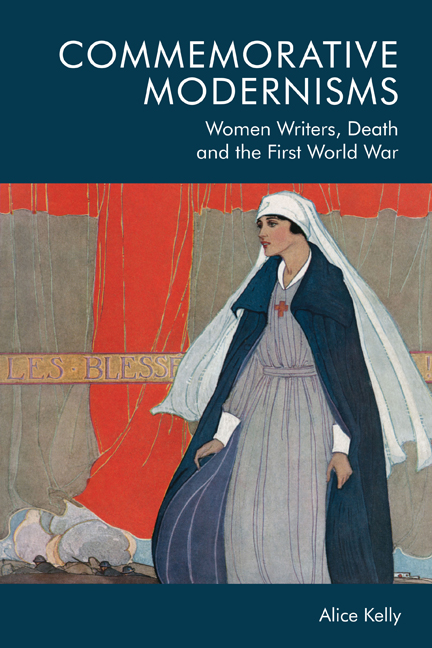Book contents
- Frontmatter
- Contents
- List of Figures
- Acknowledgements
- Dedication
- Introduction: A Culture Surcharged with Death
- Part One Death in Proximity: Wartime Commemorations
- Part Two Grief at a Distance: Civilian Modernisms
- Part Three Modernist Death: Postwar Remembrance
- Conclusion: Modernism’s Ghosts
- Bibliography
- Index
1 - The Shock of the Dead: Deathbeds, Burial Rites and Cemetery Scenes in Nurses’ Narratives
Published online by Cambridge University Press: 15 October 2020
- Frontmatter
- Contents
- List of Figures
- Acknowledgements
- Dedication
- Introduction: A Culture Surcharged with Death
- Part One Death in Proximity: Wartime Commemorations
- Part Two Grief at a Distance: Civilian Modernisms
- Part Three Modernist Death: Postwar Remembrance
- Conclusion: Modernism’s Ghosts
- Bibliography
- Index
Summary
The other day I overheard a soldier talking to another soldier about us – the men and women who stay at home. […] ‘They ought to see the towns in France,’ said the soldier. ‘They don't know there's a war on.’ I was startled by the word. ‘They.’ We and They are two nations, not one.
But there is a third nation, the nation of nurses. They are midway between us.
James Douglas, ‘How a Nurse Sees the War’ (Birmingham Gazette, 1918)‘We will send you the dying, the desperate, the moribund,’ the Inspector- General had said.
‘You must expect a thirty per cent. mortality.’
Mary Borden, The Forbidden Zone (1929)A truism of the Great War is that it turned men into numbers. In A Scottish Nurse at Work (1920), the Voluntary Aid Detachment nurse Henrietta Tayler, who worked in a Belgian military hospital, explains that they received ‘ten or twenty patients every night […] and [during] any local attack many more […] we had many, many deaths’. The numbers of dead are only described indirectly, with the emphasis on mass death compounded by the lack of specificity.
The confrontation with injury and death that nurses encountered in casualty clearing stations and military hospitals during the war was unprecedented. Much has been written on the culture shock to ‘these gently nurtured girls who walked straight out of Edwardian drawing rooms into the manifest horrors of the First World War’, but very little on how nurses coped with such large numbers of dying men.
This chapter explores the ways in which women involved in hospitals, casualty clearing stations, hospital ships and ambulance trains in the war zones and on the home front witnessed and wrote about military death in contemporary and retrospective diaries and memoirs. Focusing on intensely proximate encounters between nurses and the dying, I argue that most nurse narratives turned back to older, more conservative literary tropes for depicting the war dead – deathbed scenes, burial rituals and cemetery scenes – which attempted to convert the modern wartime hospital (in literary terms, at least) into a traditional site of mourning and commemoration.
- Type
- Chapter
- Information
- Commemorative ModernismsWomen Writers, Death and the First World War, pp. 39 - 80Publisher: Edinburgh University PressPrint publication year: 2020



